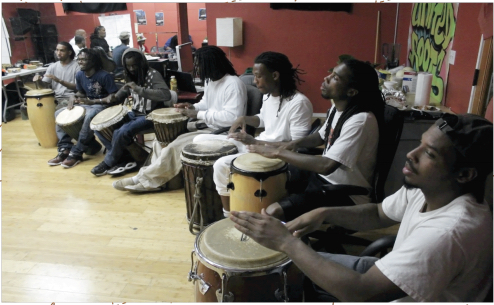Written by Iris Garcia |
ARC Towards Justice Grantee Highlight: Urban Peace Movement
This year, Urban Peace Movement (UPM) released a report, A Conceptual Mapping of Healing Centered Youth Organizing: Building a Case for Healing Justice. This report, co-authored with Nicole Lee, Dr. Shawn Ginwright and Mara Chavez-Diaz, provides a snapshot of efforts in California around healing, organizing, and activism, and presents specific practices related to using a healing-centered approach. An Akonadi grantee since 2013, Urban Peace Movement engages in building youth leadership, healing practices, and movement-building work to empower young people to overcome internalized oppression and work towards justice and social transformation. Recently, UPM has conducted campaigns aimed at economic justice and ending the school-to-prison pipeline, trained young people as Peace Ambassadors, and increased the capacity of youth-service organizations in Oakland.
In June, UPM partnered with The California Endowment to host a webinar on Healing-Centered Youth Organizing to discuss the findings from their report. The discussion also featured practitioners and organizers who are working to integrate healing into their organizing efforts with young people. Report authors Lee, Ginwright and Chavez-Diaz began with defining the key concepts and frameworks from the report: Social toxicity refers to an environment that is toxic to our health, an environment that produces fear, anxiety, stress and uncertainty. We are also affected by structural violence, as exemplified by zero tolerance policies in schools and policing practices. Healing is understood as the ability to change your perspective– to change hopelessness to courage, and self-hatred to love for oneself and one’s community, as a means to transform injury and harm into optimal health and well-being.
Healing-centered organizing is a process to increase collective power, blending a health and wellness approach with a traditional organizing approach. The principles of healing centered organizing are:
Healing is in response to the needs of the community
Healing is political
Healing and organizing intersect
Healing is found in culture and spirituality
Practitioners and organizers contributed to the discussion by sharing personal experiences of using healing-centered organizing in their work. Sammy Nunez of Fathers and Families of San Joaquin asked, “What are the metrics of love? How do you create a culture of love and healing?” Joe Kim from RYSE Center also conducted a listening campaign and received stories of trauma both in schools and at home. When RYSE asked youth what they want, this is what they heard:
Someone to listen to and care about them
Adults to heal from their own traumas
Alternatives to what they see in their communities
Opportunities to lead and learn
Itoro Udofia of Black Organizing Project (BOP), an Akonadi grant partner, shared, “Listening is an act of love.” For BOP, intentional listening allows them to hear concerns about state-sanctioned violence, black-on-black violence, unemployment and their children’s well-being. BOP responded to those concerns by advocating that a $10 million grant for police in schools be partially reallocated to restorative justice, community and teachers. BOP also successfully advocated for the elimination of willful defiance as a reason for suspension or expulsion of a student.
Akonadi Foundation affirms the importance of healing-centered organizing in the struggle for equity for youth of color. Through our Arc Towards Justice Fund, one of the goals is to build responses to harm that nurture wellness and wellbeing. We attempt to achieve this by investing in organizations using cultural strategies and healing work that develops young people’s collective expression of their experiences and visions for communities to support systems change efforts.
